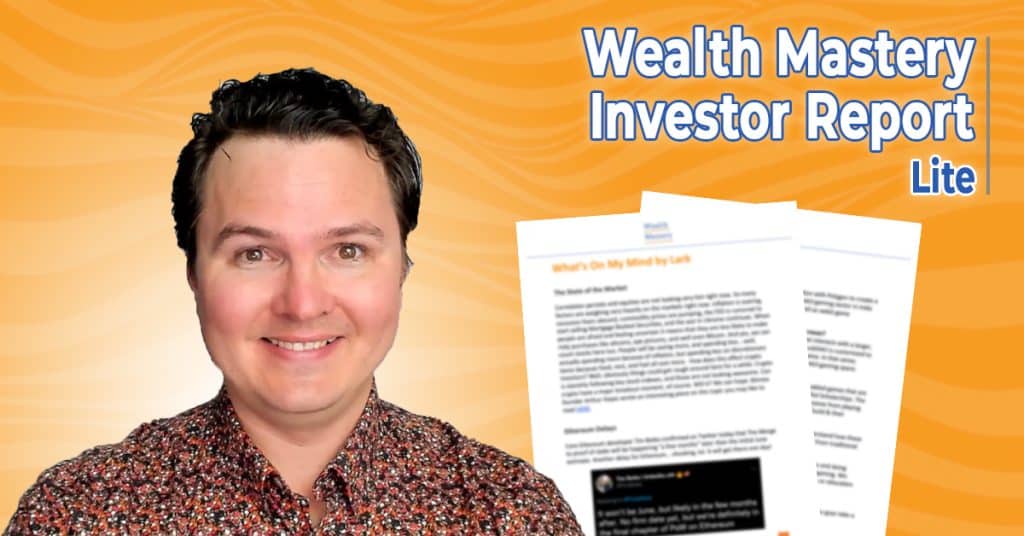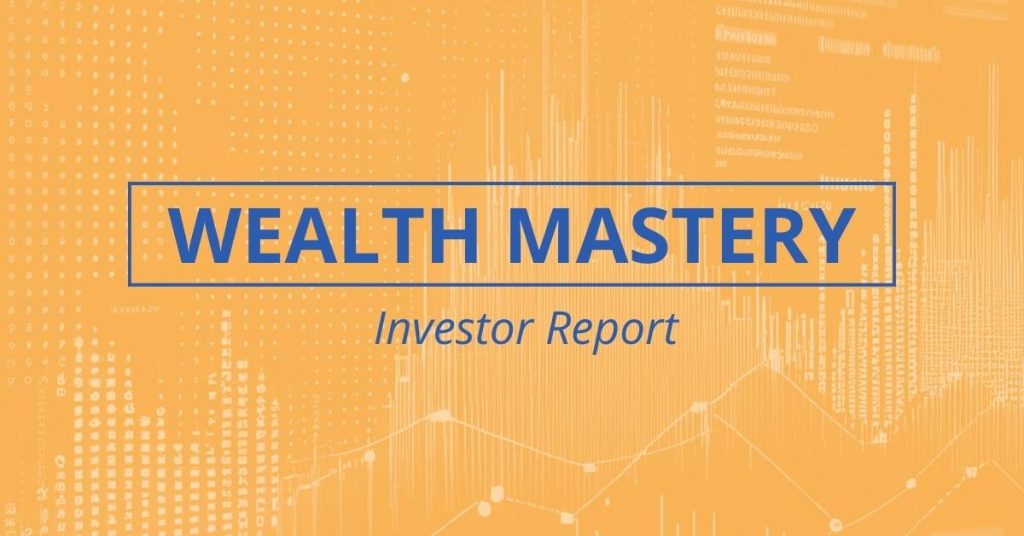The Team from Orca, The Ethereum Roadmap & The Developing Metaverse

In This Issue
- The team from Orca discusses their Autonomous AMM on Solana.
- Erik has a report for you on the Ethereum roadmap.
- David has an article about the developing metaverse.
Premium members also get the following:
- My latest portfolio updates
- Rekt Capital has the latest technical analysis for you on the market.
- Rebecca has all of the latest news for you.
- Upcoming NFT drops
- Defi Dad has a tutorial for you on how to earn up to 56% APR with staked MLP in Mycelium on Arbitrum.
- Jesse has a ton of hot new airdrops for you.
- Hot new token sales.
- Rebecca breaks down this week’s trending coins.
- Jesse has a deep dive for you on Sudoswap.
And much more!
Orca Inverview
For anyone who is not familiar, what is Orca?
Orca is a DeFi protocol on the Solana blockchain that allows users to trade tokens and provide liquidity on an autonomous basis with ease and efficiency.
Diving a little deeper, Orca offers a concentrated liquidity AMM (Automated Market-Maker), Whirlpools, with an open-source, double-audited smart contract. Built from the ground up with a focus on intuitive, human-centric design, Orca enables any protocol in Solana to easily bootstrap their own token economy, including custom liquidity pools and liquidity mining.
What does the ORCA token do?
ORCA is the governance token for the Orca protocol. ORCA tokenholders control Orca by proposing and voting on matters in Orca Governance v0! 🪙
Can you tell us about Whirlpools? Both the risks and opportunities!
Whirlpools are concentrated liquidity pools on Orca.
On most AMMs in DeFi, liquidity providers (LPs) facilitate trades at any price. For example, LPs for a SOL/USDC pool would facilitate trading for SOL from $0 to infinity.
While this model is simple, it is not capital-efficient. Thinner liquidity spread across the price curve translates to higher slippage for traders and lower yields for liquidity providers.
Whirlpools solve this problem by empowering LPs to choose what price ranges they will facilitate with their capital. LPs concentrate their liquidity in the ranges they expect the price of the token pair to move within, enabling better prices for those token pairs.
However, providing liquidity in Whirlpools is a competitive, skills-based exercise. Savvy LPs who choose more accurate price ranges (which we affectionately call “sharks” 🦈) will earn a higher share of fees and rewards. However, the potential for higher earnings comes at the risk of increased divergence loss, encouraging capital-efficient provision of liquidity.
The ORCA token is used as a reward in pools, but how sustainable is this long term?
Thanks to the capital-efficiency of Whirlpools, sharks with strong LP strategies can earn high yields from trading fees alone. This has reduced the need for additional token rewards to incentivize liquidity provision, enabling ORCA rewards to be steadily reduced over time. In fact, several Whirlpools on Orca feature no ORCA rewards at all!
How prepared is Orca to survive the bear market?
In the wild, orcas are apex predators that live in a wide range of environments. The Orca protocol, too, is well-poised to use this bear market to its advantage.
The original contributing team raised over $18 million in a private fundraise in September 2021 to continue developing Orca, placing them in a better position than competitors that may be forced to raise in a bear market. Development of Orca has continued en force over the past few months and shows no signs of stopping. New releases are on the horizon, including Community Listings, which will enable anyone in the Solana ecosystem to launch custom Whirlpools via a convenient UI.
Who are the founders and why did they decide to build Orca?
Orca was founded by Grace “Ori” Kwan (@oritheorca), who has a background in computer science and human-computer interaction from Stanford, and Yutaro Mori (@rawfalafel), a former contributor to Ethereum 2.0 with experience building across the entire crypto stack. They saw an opportunity to leverage the Solana blockchain’s superior performance to create a core “DeFi lego”: A user-friendly toolkit that enables anyone to quickly and easily bootstrap their own token economy.
Another of the founders’ goals in creating Orca was to lead the charge among web3 protocols with respect to broader positive impact. A portion of all trading fees on Orca go to charities working on climate change and sustainability, and the majority of mint revenue from the Orcanauts NFT launch went to non-profit Aflatoun International to create a crypto education program for youth.
For more info on Orca’s origins, check out this interview with Ori in Yahoo! Finance and their conversation with Solana founder Anatoly on the Solana Podcast.
What comes next for Orca?
Orca will soon be launching Community Listings, allowing users to list their own Whirlpools for tokens they love in the Solana ecosystem!
Further, Orca’s journey towards full decentralization continues. The ORCA community has always been vital to the protocol’s success, and active community governance proposals are shaping the future of the protocol as we speak.
Want to be a part of Orca’s journey? Join the Orca Discord and become a podmate! 🐳
The Ethereum Roadmap by Erik
The Ethereum Merge is by no means the final stage of Ethereum’s journey. It’s a crucial step but still won’t help Ethereum scale right away. In a recent talk, founder Vitalik Buterin sketched the milestones and end goal. In short: 100 thousand transactions per second, without sacrificing decentralization.
Buterin unfolded the Ethereum roadmap at a conference in Paris in July 2022. He claims the long-anticipated Merge will make Ethereum about 55% finished after the Merge is complete. So then what’s left to do? The end goal is to dramatically increase capacity without ultimately turning Ethereum into a massive centralized database. This requires all sorts of crafty ways to compress data and outsource data storage away from the Beacon chain.
The Ethereum Merge and everything after
The Ethereum Merge is arguably the major milestone as it replaces Ethereum’s ‘engine’: its consensus mechanism. On the surface, users will not spot the differences between before and after. We can think of the Merge as keeping the exterior of a car intact while replacing the combustion engine with an electric engine. No small feat!
All the steps that come after the Merge are less fundamental but no less important: they have to do with scalability. They ensure that Ethereum can process orders of magnitude more transactions. Those improvements have to do with revving up the engine.
Phase 1: The Merge
The Ethereum Merge has been in the works for about seven years. The upgrade is all about the switch from proof-of-work to proof-of-stake. The Beacon chain, which has been tested for almost two years, will be merged with the old Ethereum blockchain. Mining will no longer be a business model in the Ethereum ecosystem and so Ethereum post-Merge will consume 99%+ less energy than before.
Also, from an investor’s perspective, Ethereum will change. Instead of miners securing the network, it will rely on ETH owners locking up some of their ETH as collateral to earn staking yields. Staking Ether becomes like an “internet bond” with the lowest risk of all Layer 1s. We’re dealing with a fundamentally different ‘economy’ here. After the Merge, Ethereum will no longer be a ‘mine-and-dump economy’ but a ‘stake-and-hold economy’. Whereas miners have to sell sooner or later to pay their bills, stakers benefit from staking as many ETH as possible: after all, compounded interest makes one wealthy.
The reason that Ethereum proponents are calling Ether “ultra-sound money” is that Ether will probably become deflationary after the Merge. Until the Merge, the block reward for miners is about 13,000 Ether per day. After the Merge, the new amount of ETH drops to just 1,500 per day. This 90% reduction corresponds to roughly three Bitcoin halvings. Hence, this deflationary move is also called the triple halving. Subtract from that the roughly 8,000 ETH burned per day, and your back-of-the-napkin calculus will tell you that the amount of existing ETH will decrease by roughly 1-2% per year.
Phase 2: The Surge
No, the Surge is not about the expected rise in the price of Ethereum… It’s all about scaling. As Vitalik Buterin said in a July 2022 interview:
“You can lose a billion dollars from a hack but you can also lose a billion from everybody needing to pay way higher fees than they have to.”
Scaling of many orders of magnitude is essential if Ethereum wants to support a decentralized ‘world computer’ that supports thousands of apps and that is affordable to use.
When Surge? After a hopefully successful Merge, work on the Surge will begin. Completion of the Surge is expected in 2023 but of course, there are no guarantees.
The letter S in the wordplay on Merge refers to Sharding: the parallel existence of 64 blockchains or shards. This divides the huge data load that Ethereum will face (and already faces). All this data can of course not be crammed onto a single blockchain, because no one would be able to run an Ethereum node anymore. So to avoid throwing decentralization out of the window, Ethereum has to divide and conquer.
Of all 64 shards, the Beacon Chain – as the name suggests – will be the one that other shards rely on. The Beacon chain is often compared to the highway and the other shards to side roads. That’s one way to visualize it, as it conveys the image of spreading the traffic load. But this comparison misses the point that the shards will most likely not process transactions. Instead, they are used to store transaction data. So a more apt comparison would be that of the Beacon chain as the production line of the factory and the shards as data warehouses (even though it’s still a possibility that some shards will get execution rights).
Despite being (mostly) ‘just’ data warehouses, the shard chains will offer big improvements to transactions per second when combined with rollups. This is where so-called Danksharding comes in.
Danksharding
A few technical approaches have been suggested to take data load away from the Beacon chain. The details still have to be fleshed out. Danksharding is now the most likely candidate: it’s named after the developer who proposed it (Dankrad).
Danksharding works with “data availability sampling,” a technique that allows nodes on Ethereum to verify large amounts of data by sampling only a few pieces. It’s an efficiency measure and it is well-suited for the rollup era. Rollups, like sidechains, take the pressure off Ethereum by performing transactions on a separate, layer 2 chain.
Phase 3: The Verge
The Verge will introduce Verkle trees, yet another means to scale with greater efficiency. In Buterin’s view, the Verge is “great for decentralization.”
Verkle trees are of course a pun on Merkle trees, which are already used in Bitcoin and Ethereum. Merkle trees are a tool for ensuring reliable encryption by turning blocks of information into long strings of code. By adding all transactions in a block and creating a fingerprint of the entire set, it allows you to verify whether a transaction is included in the block. Verkle trees, in other words, make it possible to store a large amount of data by showing a short proof of any piece of that data. So they make the process of proof efficient. In this way, Verkle trees are a powerful upgrade to Merkle proofs. They will allow users to be network validators without having to store large amounts of data on their hard drives. Keep it decentralized!
Phase 4: The Purge
The Purge is about removing (“purging”) old data from the Ethereum blockchain. Again, this will alleviate the data storage requirements for users who want to be validators but who do not have hundreds of Terabytes available.
After the Purge, Ethereum clients will discard data older than a year. This should minimize chain clogging and allow many more transactions to be processed. Buterin expects Ethereum to process 100,000 transactions per second after the implementation of The Purge.
Ethereum devs will still have to figure out where all those old blockchain data will go. Even though they are ‘old’, they are still vital to all kinds of applications. Where do all those hundreds of terabytes of essential transaction data go? One option is Arweave, the protocol created with the explicit goal of making centuries-long data storage possible. Arweave already stores the entire blockchains of Solana and Avalanche.
Phase 5: The Splurge
According to Vitalik, the Splurge is all about the “fun stuff”. Let’s see what techniques the dev team will come up with to further scale and speed up the Ethereum ecosystem, without sacrificing decentralization.
The Developing Metaverse by David
If you haven’t read Earnest Cline’s Ready Player One, do it (skip the movie).
The novel envisions a 2040s dystopia with humanity suffering through a near-complete ecological and civilizational collapse. To cope, most humans spend most of their time plugged into the OASIS, a fully immersive metaverse with nearly endless opportunities for socialization, work, entertainment, education, adventure, and competition.
Source: The New Yorker, Ready Player One
One of the book’s thematic conflicts centers on who should have ultimate control of this metaverse. Will humanity collectively own and govern OASIS or will it be the property of Innovative Online Industries, a multinational corporation. Ready Player One is a fantastic primer for understanding both what technologists are currently developing and the importance of thoughtful considerations with regard to ownership and control of the internet.
In this article, we will analyze and compare the two largest metaverses on the market – Decentraland and Sandbox. The odds are decent that one day either one or both develop into fully immersive experiences similar to the OASIS. If this occurs, early investors will be duly compensated. I’m optimistic but rooting against the dystopian backdrop.
What is the Metaverse?
The metaverse is the idea of a fully immersive digital reality that simulates physical reality. In the metaverse, users would be able to communicate, form relationships, engage in commerce, play games, compete, learn, create, and have adventures.
The Similarities: Sandbox vs Decentraland
Decentraland and Sandbox are virtual worlds that in many ways represent the physical world. Users in both represent themselves with customizable 3D avatars and can engage in peer-to-peer communication, explore the ever-evolving landscapes, play games, compete, create, and engage in digital commerce.
Decentraland and Sandbox are Web3 metaverses powered by the Ethereum blockchain. Users can take ownership stakes of both platforms through purchasing virtual land plots, creating, owning, and trading unique user-created content, games, and businesses, and by investing in the platforms’ utility tokens. Ownership of these digital assets is verifiable on-chain via tokenization and NFTs.
Scarce land is key to the economics of both metaverses. Users can own, rent, and trade a limited supply of virtual land plots, and land owners enjoy near free reign when it comes to design and customization. User-created experiences, games, or applications must be hosted on a particular land plot where they can be monetized. Landowners can host their content or rent out their land for other creators to host their experiences.
Decentraland and Sandbox were launched in 2017 and 2021, respectively. Decentraland is currently the largest metaverse with a market cap of $1.94 billion, with Sandbox being a close runner-up at a $1.78 billion market cap.
Both metaverses are financially backed and partnered with some heavy-hitters. Decentraland has received investments from or made partnerships with FBG Capital, CoinFund, Digital Currency Group, Cyberpunk, Polygon, Samsung, and the South Korean Government. Sandbox has done the same with SoftBank, Adidas, Binance, Snoop Dogg, Atari, and CryptoKitties.
The Differences: Sandbox vs Decentraland
- Central Themes
- Decentraland is an attempt to recreate the physical world into the digital, albeit with fewer boundaries. Decentraland places a particular focus on land ownership. In Decentraland, owners utilize in-game builder tools or external software development kits to create almost anything capable of being conceived on their land.
- Sandbox is focused more as a gaming metaverse. Sandbox allows users to create, host, and monetize unique games for others to play.
- Decentralization
- True to its name, Decentraland is a fully decentralized blockchain platform and is governed by a decentralized autonomous organization (DAO). Thus, a global network of Decentraland users collectively own and govern the metaverse.
- Sandbox is a more centralized network owned by its developer, Pixowl Inc. Sandbox did launch a DAO in 2022 which apparently allows users to participate in major decisions with regard to the platform.
- Roadmap
- Decentraland does not have a clear roadmap. This is likely because the platform is governed by a DAO.
- Sandbox has a clear roadmap. This is due to the platform being owned and operated by a private company.
- Graphics
- Decentraland has older, blockier graphics, similar to Minecraft.
- Sandbox features cleaner, more modern graphics.
- Tokenomics
- Decentraland
- Uses three tokens, MANA, LAND, and WEAR.
- MANA is an ERC-20 token that is used to exchange virtual goods and services. It is also the platform’s utility and governance token.
- MANA has a current circulating supply of 1.85 billion tokens out of a total supply of 2.19 billion. MANA’s scarcity grows over time because MANA is burned when used to purchase LAND. Additionally, all market transactions require a 2.5% MANA burn fee.
- The MANA token allocation is as follows: ICO (40%), Community incentives (20%), Development team and early contributors (20%), and Decentraland allocation (20%).
- LAND and WEAR are NFTs that prove ownership of the Decentraland’s virtual land plots and wearable items, respectively. Both are technically classified as ERC-721 tokens. Users can trade both on Decentraland’s open marketplace.
- Ownership of MANA and LAND is required to be part of the governing DAO.
- Sandbox
- Uses four main tokens: SAND, ASSETS, LANDS, and GAMES.
- SAND, an ERC-20 token, is used for all transactions on the platform. Users must spend SAND to buy land, build and play games, and for trading user-created digital items. SAND is also used as the DAO’s governance token.
- SAND has a circulating supply of 1.35 billion tokens out of a max supply of 3 billion. Thus, only 45% of the tokens have been minted. The platform charges an average 5% SAND transaction fee for purchases. This revenue is then split 50/50, with half going to the Sandbox Foundation which is tasked with helping grow the platform. The other half is used to pay out staking rewards.
- ASSETS and LANDS, ERC-1155 and ERC-721 tokens respectively, are NFTs that represent the ownership of digital items and land plots in the Sandbox metaverse.
- GAMES, classified as ERC-1155 tokens, represent user-created gaming experiences in the metaverse. ASSETS and game programming must be used together to create a GAME. For a game to go live, it must be coupled with a land plot.
- Decentraland
| Quick & Dirty Decentraland vs. Sandbox Comparison | ||
| Decentraland | Sandbox | |
| Primary Token Price | $1.05 | $1.32 |
| Market Cap / Rank | $1.94B / #35 | $1.78B / #37 |
| Fully Diluted Market Cap | $2.3B | $3.9B |
| Primary Token Circulating Supply | 1.85B | 1.35B |
| Total / Max Supply | 2.19B | 3B |
| Circulating to Max Supply Ratio | 84% | 45% |
| Operating Blockchain | Ethereum | Ethereum |
| Tokens | MANA (ERC-20), LAND & WEAR (ERC-721) | SAND (ERC-20), ASSETS & GAMES (ERC-1155), & LANDS (ERC-721) |
| Marketplace Transaction Fees | 2.5% | 5% |
Decentraland vs Sandbox: Four Macro Take-Aways
- Decentraland looks to be geared more towards individuals interested in exploring a more decentralized, DAO lead metaverse.
- Due to its organizational structure, Decentraland likely offers more privacy protections for users as compared to Sandbox.
- Sandbox is likely more attractive to those for whom entertainment is the priority. With its focus on creating, hosting, and playing user-created games, combined with enhanced graphics, gamers and fun-seekers will likely flock to Sandbox.
- Not financial advice, but metaverse investors will likely want to invest in both. It seems entirely plausible, given the different organizational structures, that both systems will develop to fulfill separate use-cases for the broader market.
Final Thoughts
Decentraland and Sandbox are currently the two largest Web3 metaverse platforms on the market. Each showcase relatively rudimentary digital recreations of physical reality, but they do offer users broad license to communicate, create, consume, communicate, play, and trade with each other. The two platforms are governed in fundamentally different ways, so it will be interesting to see how each develops as a consequence.
And although these systems are not yet full-fledged VR immersive realities like Ready Player One’s OASIS, it has been integrating to watch metaverse technologies develop over the past several years, after reading the novel.
Science often follows science fiction. So making small investments in these platforms now might pay generous returns five to ten years down the road.
Final Notes
Thank you so much for your support, and I truly hope that today’s issue will give you insights needed to help you master your wealth.
If you are reading this it means you are on the free version of the Wealth Mastery Investor Report, which is great for news and tips on the crypto markets.
If you really want to take advantage of fastest growing asset class EVER, I highly recommend you join us in the Premium Investor Report.
You’ll immediately get access to:
- Deep dive Altcoin report & The Trending Coin Report
- Technical Analysis on the crypto large caps and overall market
- Token sales, Airdrops and DeFi Tutorials
- Updates on the NFT Ecosystem and new mints
- My Investment Portfolio Updates
- Monthly Crypto Alpha Report
See you next time!
Lark and the Wealth Mastery Team
Legal Disclaimer
TCL Publishing ltd (director Lark Davis, owner of Wealth Mastery) is not providing you individually tailored investment advice. Nor is TCL Publishing registered to provide investment advice, is not a financial adviser, and is not a broker-dealer. The material provided is for educational purposes only. TCL Publishing is not responsible for any gains or losses that result from your cryptocurrency investments. Investing in cryptocurrency involves a high degree of risk and should be considered only by persons who can afford to sustain a loss of their entire investment. Investors should consult their financial adviser before investing in cryptocurrency.





Responses